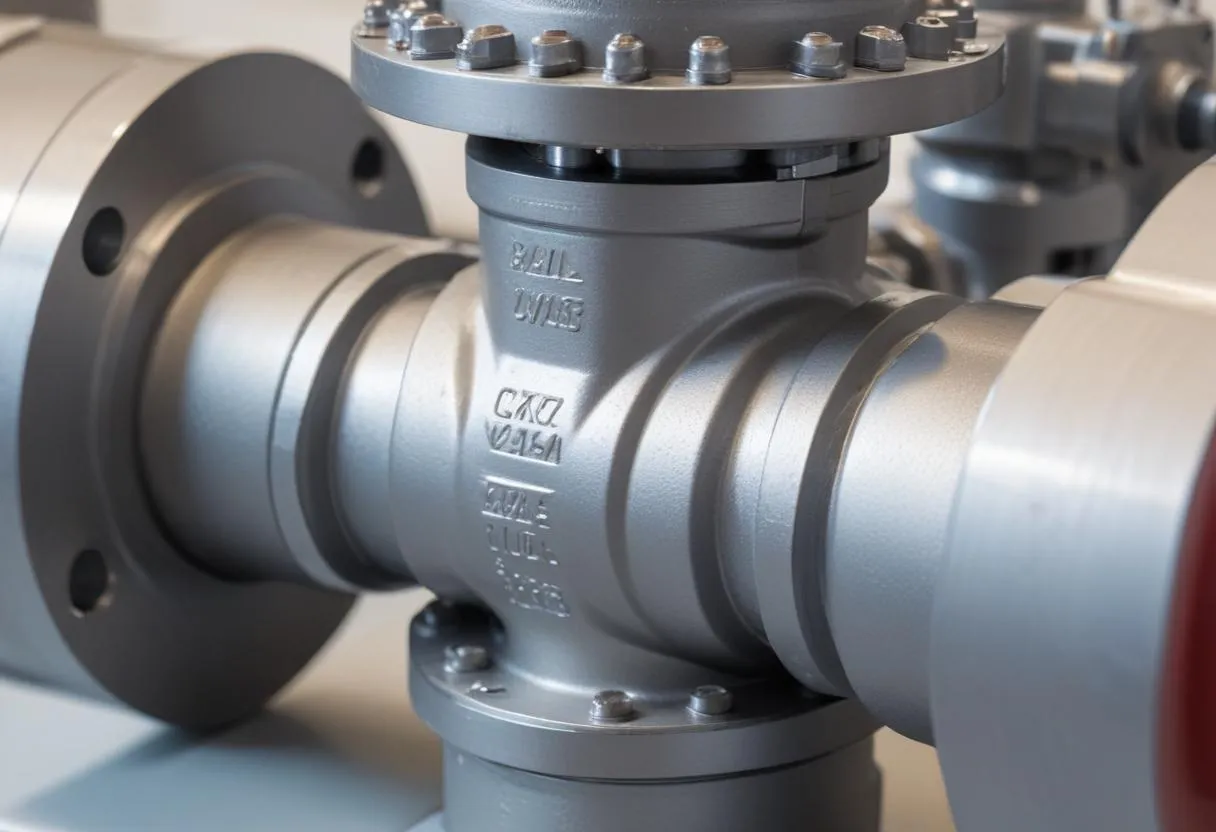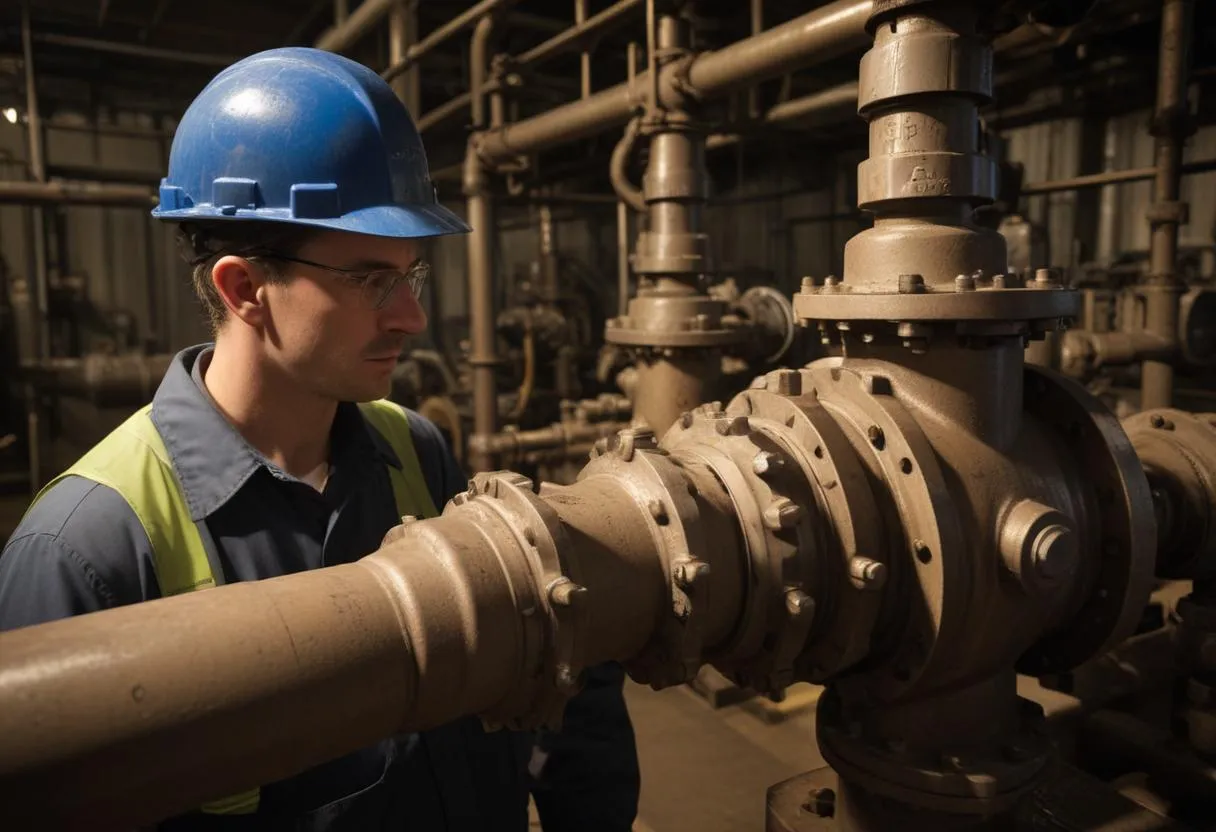 Check valves are critical components in the operation of positive displacement pumps. These valves selectively allow fluid to flow in a single direction, thereby preventing any backflow that could potentially damage the pump or disrupt the process system. The principal function of check valves in these pumps is to ensure a smooth and continuous fluid flow and to maintain the pump’s operational integrity by preventing the reverse flow of fluid during the suction and discharge cycles.
Check valves are critical components in the operation of positive displacement pumps. These valves selectively allow fluid to flow in a single direction, thereby preventing any backflow that could potentially damage the pump or disrupt the process system. The principal function of check valves in these pumps is to ensure a smooth and continuous fluid flow and to maintain the pump’s operational integrity by preventing the reverse flow of fluid during the suction and discharge cycles.
In the working mechanism of positive displacement pumps, fluid is drawn into the pump chamber through the suction valve and expelled out through the discharge valve. Check valves are typically installed at these points. During the intake stroke, the suction check valve opens up due to the decrease in pressure within the pump chamber, allowing fluid to flow into the pump. Simultaneously, the discharge check valve remains closed due to the higher internal pressure in the discharge line, ensuring the fluid has only one path to follow.
Once the intake stroke is completed, the pump initiates its discharge cycle. Here, the pressure in the pump chamber increases, pushing the fluid against the discharge check valve. As the fluid pressure overcomes the resistance of the discharge valve, it forces the valve open and the fluid exits the pump. Conversely, the increase in pressure now closes the suction check valve, preventing any fluid from flowing backwards into the feed line.
The operation of check valves is purely mechanical and they function without the need for external power or manual operation, utilizing pressure differential as their driving mechanism. The responsiveness and reliability of these valves are crucial for the efficiency of the pump, and any delay or failure in their operation can lead to inefficiencies or pump damage.
Key factors influencing the performance of check valves include:
- Valve Design: Different designs offer varying levels of responsiveness and pressure sensitivity.
- Cracking Pressure: The minimum upstream pressure required to open the valve is crucial, especially in systems with low differential pressures.
- Material Compatibility: The valve construction materials must be compatible with the fluid to prevent corrosion, which can affect valve function and lifespan.
For example, in high-pressure applications, a ball check valve might be favored due to its robust seal made by the ball fitting snugly into the valve seat, minimizing leakage. Conversely, in systems that handle viscous fluids, swing check valves may be used; their pivoting motion allows for easier handling of thick fluids without clogging.
Operational environments also dictate the choice and functioning of check valves within positive displacement pumps:
| Operating Condition | Preferable Check Valve Type |
|---|---|
| High-pressure systems | Ball check valves |
| Viscous fluids | Swing check valves |
| Low flow conditions | Diaphragm check valves |
To sum up, the operation of check valves in positive displacement pumps is essential for maintaining unidirectional flow and preventing environmental complications resulting from fluid backflow. Their automatic functionality based on pressure differences aids in safeguarding both the pump mechanism and the fluid integrity within a variety of industrial applications.
Design variations and selection criteria for check valves
Check valves come in various designs, each tailored to specific applications and operational requirements in positive displacement pumps. Understanding these variations is essential to selecting the appropriate valve for a given system, ensuring optimal performance and longevity of the pumps. Below, we explore the most common types of check valves used in these systems and outline criteria for selecting the right one.
Types of Check Valves:
- Ball Check Valves: Utilize a ball that rests on the seat, which blocks the fluid flow when required. Ideal for clean liquids and gases, these valves perform well under high pressure and varying flow rates without sustaining damage.
- Swing Check Valves: Have a disc that swings on a hinge or trunnion, either onto the seat to block reverse flow or off the seat to allow forward flow. They are suitable for systems with a significant flow that prevents the disc from slamming shut.
- Diaphragm Check Valves: Use a flexible diaphragm that opens under forward flow and seals back against a seat to block backflow. These valves are excellent for handling slurry or semi-solid fluids and systems with low flow rates.
- Duckbill Check Valves: Feature a flexible, tube-shaped design that operates based on differential pressure. These are best for applications with abrasive materials or those requiring tight sealing without any risk of blockage.
Selection Criteria for Check Valves:
When choosing the appropriate check valve for positive displacement pumps, several factors must be considered:
- Flow Requirements: The valve must accommodate the system’s flow rate without causing significant head loss or pressure drop.
- Fluid Characteristics: The compatibility of valve materials with the fluid in terms of corrosion, viscosity, and presence of solids is crucial.
- Pressure Rating: The valve should withstand the maximum system pressure. However, the cracking pressure — the minimum pressure required to open the valve — must also align with system dynamics.
- Backflow Prevention: The valve’s design should ensure tight sealing when closed to prevent any backflow, which is critical in systems like those handling hazardous or contaminating materials.
- Installation Environment: Environmental factors such as temperature, humidity, and external corrosive elements should influence the choice of valve design and material.
- Maintenance Needs: Consider valves that are easy to maintain and repair, reducing downtime and extending the lifecycle of the pump and system.
Evaluating these factors will help in selecting the right check valve, which is not only pivotal for the efficiency of positive displacement pumps but also for the safety of the handling system. Each type of check valve serves a distinct purpose and aligns with specific operational conditions, thus making the appropriate selection paramount.
Maintenance practices and troubleshooting common issues
 Maintaining check valves in positive displacement pumps efficiently is crucial to ensure operational stability and prolong the lifespan of the pump systems. Regular maintenance and adept troubleshooting can prevent potential failures and preserve the system’s integrity. Below are the best practices and common troubleshooting guidelines for check valves.
Maintaining check valves in positive displacement pumps efficiently is crucial to ensure operational stability and prolong the lifespan of the pump systems. Regular maintenance and adept troubleshooting can prevent potential failures and preserve the system’s integrity. Below are the best practices and common troubleshooting guidelines for check valves.
Maintenance Practices:
- Regular Inspection: Periodic physical inspections are essential to detect any wear or damage early. Check for signs of leakage, cracking, or any abnormalities in the valve operation.
- Cleaning: Depending on the fluid handled, valves should be cleaned to prevent clogging and buildup, which can impair their operation. Cleaning schedules may vary from one environment to another based on the fluid characteristics and system’s usage.
- Lubrication: If the valve design includes components that require lubrication, ensure that this is carried out at recommended intervals using suitable lubricants.
- Replacement of Worn-Out Parts: Components like springs, seals, and seats are prone to wear and should be checked regularly. Replace any worn parts as needed to maintain optimal functionality.
- Functional Testing: Conduct regular tests to ensure the valve opens and closes at the correct pressures, and operates as intended across different operating conditions.
Troubleshooting Common Issues:
In case of performance issues with check valves in positive displacement pumps, identifying the root cause is paramount. Here are some common problems and their potential solutions:
| Common Issue | Possible Cause | Suggested Solution |
|---|---|---|
| Valve does not open | Blockage or stuck component | Inspect and clean the valve. Check for damaged components and replace if necessary. |
| Leakage when closed | Worn or damaged seal | Replace the sealing element. Ensure correct installation of the new seal. |
| Noisy operation | Loose internal components or cavitation | Secure any loose parts. If cavitation is suspected, consider modifying system conditions to reduce it, or select a more suitable valve type. |
| Excessive wear | Improper material selection or alignment issues | Evaluate the fluid characteristics and operational conditions. Replace with a valve made of more suitable materials and ensure proper installation alignment. |
Addressing these common issues promptly can dramatically reduce downtime and operating costs while ensuring that the system remains effective and safe. Regular training for maintenance personnel on these aspects is also vital, as a well-informed team can significantly enhance the reliability and efficiency of pump operations. By adhering to the outlined maintenance practices and being equipped to troubleshoot common issues, operators can ensure that check valves continue to function optimally within their positive displacement pump systems.